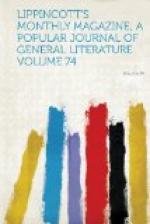Hail, city well named “Brother’s Love!” The Quaker City of the dove, That fain would call a land to fling Its spites away, and ’neath thy wing Renew the treaty made by Penn In the wildwood with wilder men; Yet true men still! Be this the token—– loyal faith, a pledge unbroken!
O year that wear’st thy aloe-flower
So proudly! may thy touch have power
Of healing! May thy visage bland
Drive threatening discord from the land,
And throned Peace more firmly fix!
Then shall the elder ’76,
From out the eighteenth century’s
band
Of Time’s host in the shadowy land,
Greet thee as one true soul may smile
Upon another, where nor guile
Nor sorrow can its brightness dim.
So greet the clear-eyed seraphim—
So once in Eden’s sinless bower
Unfading flower smiled on flower.
LATIENNE.
THE KREUZESSCHULE.
OBER-AMMERGAU, BAVARIA, OCT. 4, 1875.
The town lies at the end of a lovely green valley. Behind it are fir-clad mountains with rocky peaks: on one side a great square rocky peak, which towers above all and is surmounted by a cross. On each side of the valley sloping hills, fir-clad to the top. A rapid, clear stream runs by on the edge of the village. Green pastures dotted with haymakers, a few scattered trees and a distant town fill the charming valley. Virginia creepers hang on the walls, and gay flowers fill pretty balconies and peep through sunny little casements. All is simple and neat, and the bright fresco pictures on the fronts of many houses lighten it all.
On a high hill overlooking the town they are placing a colossal crucifixion group, presented by King Ludwig II. in Erinnerung an die Passionsspiele—in memory of the Passion play—Christ on the cross, with the Virgin and St. John, one on each side. The two latter were ready to be hoisted on to the pedestal: the former is partly up the hill. All are surrounded by heavy planking, so that it is impossible to judge of the artistic merit, but the great group cannot fail to have a fine effect when viewed from a distance.
Yesterday (October 3d) was the eventful day. Our tickets had been ordered by telegraph, and we had “the best seats.” The performance was to begin at nine o’clock, and at a quarter before nine we were in our places.
The building in which the play is given is of plain rough wood without paint ("or polish"); in the interior a gallery and two side-galleries, below them a parterre, and on each side of it a standing-place, all of plain, unpainted boards. The orchestra was sunk below the level of the stage, the proscenium painted to represent columns and entablature. The curtain represented, or seemed intended to represent, Jerusalem. The whole place could not probably contain over six hundred people, and was about half full. There were very few foreigners.




